 etween 1924 and 1932, as increasingly more events were being hosted
in the town of Kuala Lumpur (it had been the capital of the Federated
Malay States since 1895), there were increased calls for volunteers
and helpers. While there were other groups like the Cadets, people
were more eager to call on the assistance of the Scouts. Parallel with
this development, it must be noted that the First Selangor Group was,
until 1925, the sole Troop in Selangor. Equally important, it was the
Troop from the premier school of the region. So who else to call upon
other than the V.I. Scouts when help was needed? Thus, the V.I. Scouts
found themselves involved in a myriad of activities that kept them
occupied week after week.
etween 1924 and 1932, as increasingly more events were being hosted
in the town of Kuala Lumpur (it had been the capital of the Federated
Malay States since 1895), there were increased calls for volunteers
and helpers. While there were other groups like the Cadets, people
were more eager to call on the assistance of the Scouts. Parallel with
this development, it must be noted that the First Selangor Group was,
until 1925, the sole Troop in Selangor. Equally important, it was the
Troop from the premier school of the region. So who else to call upon
other than the V.I. Scouts when help was needed? Thus, the V.I. Scouts
found themselves involved in a myriad of activities that kept them
occupied week after week.
However, it was not just external factors that accounted for the busy-ness of the V.I. Scouts. The V.I. Scout movement had many dedicated and committed teachers who voluntarily gave of their time to instruct and examine the Scouts in different aspects of Scoutcraft. Teachers like Mr M.A. Akbar and Mr Ganga Singh became Assistant District Commissioner and District Scout Master respectively. Even the V.I. Headmasters were actively involved, a tradition continued even after the Second World War! It was of no surprise then that the V.I. Scouts were admired far and wide for their abilities.
RECOGNITION OF THE V.I. SCOUT MOVEMENT
The V.I. Scouts and Scout Masters were instrumental in establishing
Troops in other schools such as ACS Klang and Maxwell School. Perhaps the zenith of
this trailblazing occurred on Empire Day, 15 May 1926. Mr Frank C.
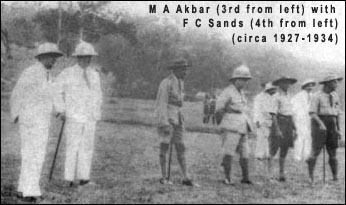 Sands, the Chief Scout Commissioner for Malaya, often inspected V.I. Scout
parades, be they ordinary Troop parades or march pasts in major public
events. After the 1926 Empire Day Inspection, there was a Grand Rally at which
Mr Sands addressed the V.I. Scouts and Cubs. With the District Scout Master,
Mr M.A. Akbar beside him, Mr. Sands commended the boys on their good turnout,
reminding them that they were the pioneers of the movement in the State and had
been the only Scouts in the State for a good long time. The V.I. Scouts had kept
up the movement without a break (The Methodist Boys’ School and St John’s
Institution incidentally had started Troops in 1910 just after the V.I., but
those Troops were subsequently disbanded). Such activeness, he said, was due to
Mr M.A. Akbar who had, in sixteen years of service, worked hard for the Troops,
keeping the interest going in spite of all difficulties. There were many times
when Mr Akbar had to manage things single-handedly. Hence the Chief Commissioner
thought it fitting that Mr Akbar should hold a new office, that of Assistant
District Commissioner for Selangor.
Sands, the Chief Scout Commissioner for Malaya, often inspected V.I. Scout
parades, be they ordinary Troop parades or march pasts in major public
events. After the 1926 Empire Day Inspection, there was a Grand Rally at which
Mr Sands addressed the V.I. Scouts and Cubs. With the District Scout Master,
Mr M.A. Akbar beside him, Mr. Sands commended the boys on their good turnout,
reminding them that they were the pioneers of the movement in the State and had
been the only Scouts in the State for a good long time. The V.I. Scouts had kept
up the movement without a break (The Methodist Boys’ School and St John’s
Institution incidentally had started Troops in 1910 just after the V.I., but
those Troops were subsequently disbanded). Such activeness, he said, was due to
Mr M.A. Akbar who had, in sixteen years of service, worked hard for the Troops,
keeping the interest going in spite of all difficulties. There were many times
when Mr Akbar had to manage things single-handedly. Hence the Chief Commissioner
thought it fitting that Mr Akbar should hold a new office, that of Assistant
District Commissioner for Selangor.
That same day, a public meeting was held at the Victoria
Institution, the object of which was the formation of a Selangor Boy Scouts Local
Association. The Honourable Mr H.W. Thomson, the British Resident, was the chair
and those
 in attendance included Mr Sands, representatives from the Girl Guides’
Association and the Negri Sembilan Boy Scouts’ Association. The proposal for
forming the Association was passed unanimously and the Resident was asked to
become the Association’s president. Two former V.I. Scout Masters, Mr E.S.
Redfearn and Mr M.A. Akbar were automatically inducted into the committee
because of their roles as Assistant District Commissioners, assisting the
District Commissioner Mr J.R. Kellam. The V.I. Scout movement was, indeed,
‘reaching out’. Thus 15 May 1926 became a red-letter day in Scouting annals.
With his well-merited promotion, Mr Akbar continued to serve the movement
creditably and, in 1930, was awarded the Bar of the Medal of Merit by the
Chief Scout Lord Robert Baden-Powell on the occasion of Mr Akbar’s 20th year
in service.
in attendance included Mr Sands, representatives from the Girl Guides’
Association and the Negri Sembilan Boy Scouts’ Association. The proposal for
forming the Association was passed unanimously and the Resident was asked to
become the Association’s president. Two former V.I. Scout Masters, Mr E.S.
Redfearn and Mr M.A. Akbar were automatically inducted into the committee
because of their roles as Assistant District Commissioners, assisting the
District Commissioner Mr J.R. Kellam. The V.I. Scout movement was, indeed,
‘reaching out’. Thus 15 May 1926 became a red-letter day in Scouting annals.
With his well-merited promotion, Mr Akbar continued to serve the movement
creditably and, in 1930, was awarded the Bar of the Medal of Merit by the
Chief Scout Lord Robert Baden-Powell on the occasion of Mr Akbar’s 20th year
in service.
The V.I. Scouts also established close rapport with the District Commissioner, Mr Kellam, who contributed a challenge trophy for an inter-patrol competition between the patrols of all the V.I. Troops. After Mr Kellam's departure, his successor, Mr Marcus Dukes, barely in office twelve days, paid a visit to the school on 20 June 1929. He was received with a general salute and proceeded to inspect the ranks, during which he questioned the Scouts on the Scout Laws and in the uses of the various knots. Emergency drill was practised under the command of Mr Dukes and, after this, a Message Relay Race was run in Patrols. A short practice in jujitsu ended the programme for the day.
The British Residents for Selangor also had high praise for
the V.I. Troops whenever they saw them in action. Residents like Mr O.F. Stoner,
 Mr E.W.F. Gilman and Mr A. Caldecott were reported as being deeply
impressed by the Scouts during the Empire Day celebrations of various
years. As has been mentioned, in 1925, the Selangor royalty had even
offered to present the Royal Colours to the Troop! Truly the Scout
movement was held in such high esteem that when the Selangor Scouts
held a camp in Morib in 1926, the Sultan very kindly lent them a
bungalow. Other Scout associations also regarded the V.I. Scouts
highly, inviting them to their functions. In 1928, the V.I. Scouts
were invited to the first Grand Rally of the newly formed Malay Troops
at the Kampung Baru Padang on July 12, as well as to the Klang Scouts
rally cum ‘White Honey’ Inter-patrol Competition of the Fifth Selangor
Troop of the ACS Klang. It was also reported in Scouting In Malaya,
September 1929 that, during a jamboree in Singapore, the Singapore
Scouts "were very pleased to welcome to our Jamboree the Troop
Leader and one of the Patrol Leaders from the Victoria Institution
Troop, Kuala Lumpur". In effect, the TL and PL were treated as
Guests-of-Honour!
Mr E.W.F. Gilman and Mr A. Caldecott were reported as being deeply
impressed by the Scouts during the Empire Day celebrations of various
years. As has been mentioned, in 1925, the Selangor royalty had even
offered to present the Royal Colours to the Troop! Truly the Scout
movement was held in such high esteem that when the Selangor Scouts
held a camp in Morib in 1926, the Sultan very kindly lent them a
bungalow. Other Scout associations also regarded the V.I. Scouts
highly, inviting them to their functions. In 1928, the V.I. Scouts
were invited to the first Grand Rally of the newly formed Malay Troops
at the Kampung Baru Padang on July 12, as well as to the Klang Scouts
rally cum ‘White Honey’ Inter-patrol Competition of the Fifth Selangor
Troop of the ACS Klang. It was also reported in Scouting In Malaya,
September 1929 that, during a jamboree in Singapore, the Singapore
Scouts "were very pleased to welcome to our Jamboree the Troop
Leader and one of the Patrol Leaders from the Victoria Institution
Troop, Kuala Lumpur". In effect, the TL and PL were treated as
Guests-of-Honour!
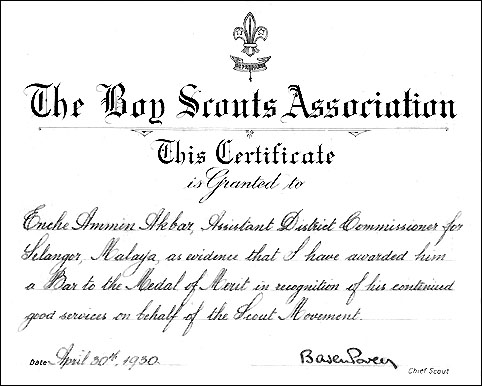
One very momentous sign of recognition occurred on Armistice Day, 11 November 1930. Before the assembled Scout Troops of Selangor, the First Selangor Group were presented with a Troop flag by the Chief Justice W. Elphinstone. The ADC Mr Stowell (who was also the V.I. Headmaster) addressed the Troop, reminding them that the flag was their challenge to carry out their threefold promise. They had to ward off the ‘cunning enemy’ who would tempt them to be too slack to turn up for patrol meetings, too slack to practise their Morse code, too slack to do good turns, or too slack to go to camp. If they yielded, they would be surrendering their flag. The flag was later escorted in a slow march before the Troop which presented staffs.
SUCCESS DUE TO STRONG FOUNDATIONS AND STRUCTURE
The V.I. Scout movement would have fumbled had it not been for the continuous service by many stalwarts of Scouting, who were experts in various fields of Scoutcraft. They had gladly served the Troop voluntarily, without reward and yet with utmost willingness. In acknowledgement for their services, the Swastika Badge of Friendship was presented by the V.I. Troops to those who had contributed significantly. Those who received the award included Mr W. Towle (the pioneering leader of the ‘Fire Section’ and the source of reference for the Fireman’s Badge since 1920), Mr Choong Wan Chan (the first King Scout and subsequently a Scout Master) and Mr R.J.H. Sidney (the second V.I. Headmaster on his retirement).
Over the years, the V.I. Scouts continued to undergo restructuring in order to achieve an efficient organisation framework. In March 1925, Mr E.S. Redfearn (then the DC for Selangor) reconstituted the First Selangor Scouts into four Troops. The First Selangor Troop continued under the charge of Mr Akbar, while the Second, Third and Fourth Selangor Troops were placed under Mr N. Sundarajalu, Mr Ganga Singh and Mr Choong Wan Chan. (Note, however, that the Second Selangor Troop is not the predecessor of the present 2nd Kuala Lumpur group.) Over the next few years, there were various changes in the Scout Mastership of the Troops:
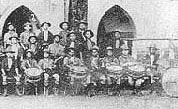 V.I. boy could be both a Scout and a member of the V.I. Cadet Corps. As
such, there was sharing of resources and training. As previously noted,
Scout Master Wan Chan instructed the cadets in marksmanship, helping them
win the Leslie Shield in 1925. As well, the Scouts had a bugle section.
There is a now-widely used photo of the Drum and Fife section of the V.I.,
posing in front of the old High Street building, where many of the members
are attired in Scout uniform. However, in early 1928, this official
intertwining of cadets and Scouts ceased. A new rule was introduced
which stipulated that no boy who was a member of the V.I. Cadet Corps
would continue as a Scout unless his services were required as Troop
Leader or Patrol Leader.
V.I. boy could be both a Scout and a member of the V.I. Cadet Corps. As
such, there was sharing of resources and training. As previously noted,
Scout Master Wan Chan instructed the cadets in marksmanship, helping them
win the Leslie Shield in 1925. As well, the Scouts had a bugle section.
There is a now-widely used photo of the Drum and Fife section of the V.I.,
posing in front of the old High Street building, where many of the members
are attired in Scout uniform. However, in early 1928, this official
intertwining of cadets and Scouts ceased. A new rule was introduced
which stipulated that no boy who was a member of the V.I. Cadet Corps
would continue as a Scout unless his services were required as Troop
Leader or Patrol Leader. 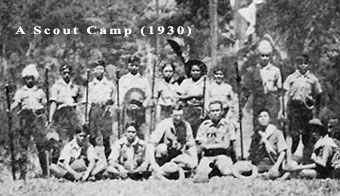
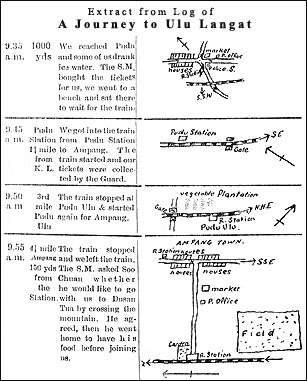 places like Dhoby Valley (near the present site of Istana Negara)
and Spion Kop, to reach their destination. Not only that, Mr Akbar,
one of the oldest pathfinders in Kuala Lumpur, gave them a task in
reconnoitring, instructing them to find their way to the destination
on their own accord while he trailed behind. Thus the Scouts had to
plan and inform him as to the direction they were heading. In 1927, a
Field Day was held in the Dhoby Valley, after which DC Kellam held an
Investiture Ceremony for the new Tenderfoot Scouts who had passed all
their tests.
places like Dhoby Valley (near the present site of Istana Negara)
and Spion Kop, to reach their destination. Not only that, Mr Akbar,
one of the oldest pathfinders in Kuala Lumpur, gave them a task in
reconnoitring, instructing them to find their way to the destination
on their own accord while he trailed behind. Thus the Scouts had to
plan and inform him as to the direction they were heading. In 1927, a
Field Day was held in the Dhoby Valley, after which DC Kellam held an
Investiture Ceremony for the new Tenderfoot Scouts who had passed all
their tests.  Masters also ensured that the boys acquired as many ‘non-badge’ skills
as possible and to expand their fields of expertise. In 1929, the
Scout Master Mr Goh Keng Kwee taught jujitsu to a few enthusiasts. As
well, The Victorian of 1929 notes that the Troop also possessed
"what is probably the best Orchestra in the State"!
General leadership skills were also emphasised. Scout Master Mr Goh
Keng Kwee of the First Selangor Troop 1B held Patrol Leaders’ Training
Camps between 19 to 21 September 1931 on the school grounds and also
between Friday 9 September to Monday 12 September 1932 at Castle Camp.
(See
Masters also ensured that the boys acquired as many ‘non-badge’ skills
as possible and to expand their fields of expertise. In 1929, the
Scout Master Mr Goh Keng Kwee taught jujitsu to a few enthusiasts. As
well, The Victorian of 1929 notes that the Troop also possessed
"what is probably the best Orchestra in the State"!
General leadership skills were also emphasised. Scout Master Mr Goh
Keng Kwee of the First Selangor Troop 1B held Patrol Leaders’ Training
Camps between 19 to 21 September 1931 on the school grounds and also
between Friday 9 September to Monday 12 September 1932 at Castle Camp.
(See 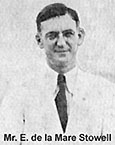 Troop was second in the competition while the Second Troop secured the
wooden spoon. Those who judged the competition were the Headmaster, DC
Kellam, ADC’s Akbar and M.J. Dowty, SM Peethamparam, Cubmaster Hung Chin,
two former Scout Masters Mr Redfearn and Mr Choong Wan Chan, and Mr
Choon Wing Hong, a V.I. teacher and 1916 Rodger Medallist.
Troop was second in the competition while the Second Troop secured the
wooden spoon. Those who judged the competition were the Headmaster, DC
Kellam, ADC’s Akbar and M.J. Dowty, SM Peethamparam, Cubmaster Hung Chin,
two former Scout Masters Mr Redfearn and Mr Choong Wan Chan, and Mr
Choon Wing Hong, a V.I. teacher and 1916 Rodger Medallist. 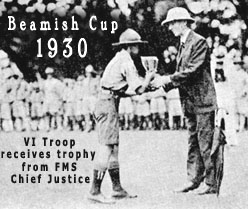 that inaugural year, the Beamish Cup competition was held in connection
with the Selangor Jamboree at the V.I. field on 6 August. Ten Troops
competed, with the First Selangor Troop playing second fiddle to the
triumphant Sixth Selangor Troop of Maxwell Road School. The Fourth and
Third Troops were third and fourth respectively. In the 1931 Beamish Cup
competition, however, after an inspection by ADC Mr Davidson, the First
Selangor Group were sufficiently inspired to emerge first.
that inaugural year, the Beamish Cup competition was held in connection
with the Selangor Jamboree at the V.I. field on 6 August. Ten Troops
competed, with the First Selangor Troop playing second fiddle to the
triumphant Sixth Selangor Troop of Maxwell Road School. The Fourth and
Third Troops were third and fourth respectively. In the 1931 Beamish Cup
competition, however, after an inspection by ADC Mr Davidson, the First
Selangor Group were sufficiently inspired to emerge first. 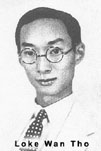 was the Loke family. Loke Wan Tho, the son of the philanthropist Towkay
Loke Yew, was a PL in the Second Selangor Troop, and later in 1929,
when the V.I. only had one Troop, became a PL in the First Selangor
Troop. On 3 April 1929, the First Selangor Troop had a picnic at Klang
Gates, where they spent an enjoyable time swimming, mountaineering,
cooking and singing. This trip was made possible as PL Loke Wan Tho and
Scout Chu Kah Yoon provided four large cars for the party.
was the Loke family. Loke Wan Tho, the son of the philanthropist Towkay
Loke Yew, was a PL in the Second Selangor Troop, and later in 1929,
when the V.I. only had one Troop, became a PL in the First Selangor
Troop. On 3 April 1929, the First Selangor Troop had a picnic at Klang
Gates, where they spent an enjoyable time swimming, mountaineering,
cooking and singing. This trip was made possible as PL Loke Wan Tho and
Scout Chu Kah Yoon provided four large cars for the party.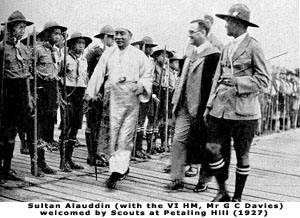
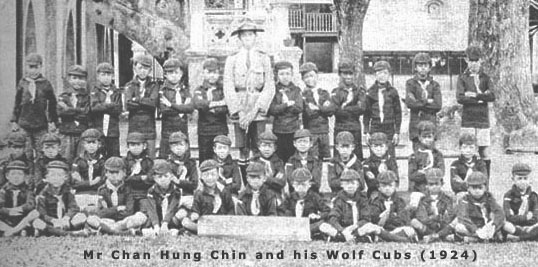
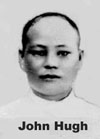 which clouded the lives of V.I. Scouts from time to time. In those
days when the life expectancy rate was much lower than say, of the
1990’s, the Scouts were occasionally hit by sad news of the deaths
of fellow Scouts or Scouters. On 24 September 1925, the Scouts learned
of the death, in England, of Mr W. Towle who was so instrumental in
setting up the ‘Fire Section’ of the First Selangor Troop. Then sometime
at the end of 1925, the Scouts were shocked by the untimely death of Mr
Hugh John who was Assistant Scout Master of the First Troop between 1915
and 1918. He was also one of the scouts in Mr Shaw's first list of V.I.
(and Malayan!) scouts in the First Selangor Troop in 1910. Besides
mourning the deaths of former Scouts, the V.I. Troops also shared in the
grief of Scouts who had lost their relatives. For instance, The
Victorian of 1928 recorded condolences to ADC Akbar on the untimely
death of his sister Afzah.
which clouded the lives of V.I. Scouts from time to time. In those
days when the life expectancy rate was much lower than say, of the
1990’s, the Scouts were occasionally hit by sad news of the deaths
of fellow Scouts or Scouters. On 24 September 1925, the Scouts learned
of the death, in England, of Mr W. Towle who was so instrumental in
setting up the ‘Fire Section’ of the First Selangor Troop. Then sometime
at the end of 1925, the Scouts were shocked by the untimely death of Mr
Hugh John who was Assistant Scout Master of the First Troop between 1915
and 1918. He was also one of the scouts in Mr Shaw's first list of V.I.
(and Malayan!) scouts in the First Selangor Troop in 1910. Besides
mourning the deaths of former Scouts, the V.I. Troops also shared in the
grief of Scouts who had lost their relatives. For instance, The
Victorian of 1928 recorded condolences to ADC Akbar on the untimely
death of his sister Afzah.